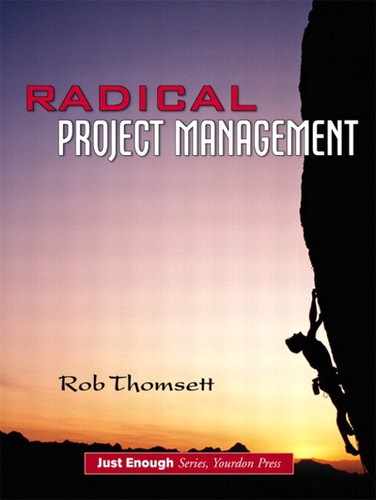eXtreme Tool 1: Success Sliders
 | The concept of success criteria provides the basis of our first eXtreme project management tool. |
Like all the tools our group has developed to assist project managers, stakeholders and teams, it is both simple and sexy.
We based this tool on the concept of a lightswitch with a dimmer slider. During the RAP session, each stakeholder determines which of the success criteria is either on or off (see Figure 7.2). If the success slider is on for that stakeholder, then there can be a graduation from dim to bright. If a slider is totally on, there is no room for compromise. If the slider is partially on, the stakeholder is saying that there is considerable room to move in meeting that criterion.
Figure 7.2. Success sliders

 | Simple is sexy; complex sucks. |
If a slider is off, it indicates that that criterion is not significant as a measure of success. For example, if budget is off, it means that the stakeholder is prepared to sacrifice the budget for other more important factors. It is important to note that the budget is still tracked and measured. Everything is negotiable.
By now, it should be pretty clear to you that the chances of 10 different stakeholders agreeing on how to define success for the same project are slim. This is where the project sponsor starts to earn his or her money. As we'll discuss in Part 3, the sponsor has the right to unilaterally override the project stakeholders.
What you have to do is to document the disagreements and then let the sponsor decide where the sliders should be set.
 | The best time to negotiate project success is before the project starts. |
Let's NegotiateDon't be surprised if a stakeholder puts all the sliders fully on. They are simply negotiating with you by stating their most preferred position (MPP). We have used this tool on hundreds of projects and have never seen a project with all the sliders fully on. People are pragmatic and will trade off. |
What is really important is that you have a simple, nontechnical tool to begin the process of negotiating with the stakeholders. More significantly, it is the stakeholders who decide, not you. Even if the sponsor overrides their views, they will know that you are simply providing a mechanism for this to happen.
Don't Panic! It Is Meant to Be Subjective
Some of you may be feeling that the sliders are not precise and quantified. This is the very power of this tool. It has been designed to get a feel for the stakeholders' expectations. We have used this tool on hundreds of projects and it has never failed. The precision and measures are added as you proceed to the other tools in the RAP session. We have more on the power of the sliders in Chapter 23, “The Success Sliders Redux.”
Welcome to eXtreme project management.
The P Files Episode 4: The Whoops FactorWe were showing the success sliders to a chief executive officer (CEO) and a number of his direct reports. The chief information officer (CIO) of the company became agitated and stated, “This tool can't work. There are no measures. It is all too subjective!” Meanwhile, the CEO had been quietly completing the slider tool and, raising his head, he replied, “I like this tool. These are my expectations for Project Blaster.” As he showed his executive team his slider scores, there was an audible gasp from the CIO. She had completely misunderstood the expectations for Project Blaster, which was already well underway. Her team had been compromising quality to meet the deadline. The CEO had scored quality as totally On and time as 25% On. Needless to say, the slider tool became a critical part of that organization's project management approach. The P Files Team Comment This situation is so common that it would be laughable if it wasn't so serious. Make sure that you know which factors matter to your sponsor before you start the project. |
Case Study—Success SlidersYou have Edwina and the other stakeholders together in a room and, after a brief introduction by Edwina, you show them the success sliders and explain the tool to them. Edwina and the stakeholders agree that the majority of people using their Web site must be happy with it (particularly the executives) and that quality is critical. They also agree that the deadline is tight (Edwina would like it quickly) and that the budget is tight (but not fixed). They see that the added value is very important, but the Web site does not have to be fully featured at the initial launch.
|

